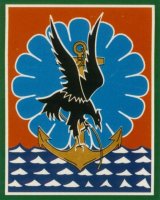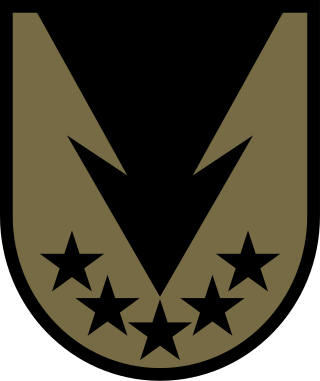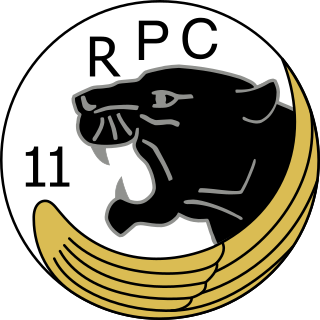
A paratrooper is a military parachutist—someone trained to parachute into a military operation, and usually functioning as part of an airborne forces. Military parachutists (troops) and parachutes were first used on a large scale during World War II for troop distribution and transportation. Paratroopers are often used in surprise attacks, to seize strategic objectives such as airfields or bridges.

The Directorate-General for External Security is France's foreign intelligence agency, equivalent to the British MI6 and the American CIA, established on 2 April 1982. The DGSE safeguards French national security through intelligence gathering and conducting paramilitary and counterintelligence operations abroad, as well as economic espionage. It is headquartered in the 20th arrondissement of Paris.

The Commandos Marine are the special operation forces (SOF) of the French Navy. The Commandos Marine are nicknamed Bérets Verts. They operate under the Maritime Force of Sailor riflemen and Navy Commandos (FORFUSCO) and form part of the French Special Operations Command.

A parachutist badge is a military badge awarded by the armed forces of many states to soldiers who have received parachute training and completed the required number of jumps. It is difficult to assess which country was the first to introduce such an award.

The 2nd Foreign Parachute Regiment is the only airborne regiment of the Foreign Legion in the French Army. It is one of the four infantry regiments of the 11th Parachute Brigade and part of the spearhead of the French rapid reaction force.

The 1st Marine Infantry Parachute Regiment or 1er RPIMa is a unit of the French Army Special Forces Command, therefore part of the Special Operations Command.
The structure of the French Army is fixed by Chapter 2 of Title II of Book II of the Third Part of the Code of Defense, notably resulting in the codification of Decree 2000-559 of 21 June 2000.

The 11th Parachute Brigade is a one of the French Army's airborne forces brigade, predominantly light infantry, part of the French paratrooper units and specialized in air assault, airborne operations, combined arms, and commando style raids. The brigade's primary vocation is to project in emergency in order to contribute a first response to a situational crisis. An elite unit of the French Army, the brigade is commanded by a général de brigade with headquarters in Balma near Toulouse. The brigade's soldiers and airborne Marines wear the red beret (amaranth) except for the Legionnaires of the 2ème REP who wear the green beret.

The 8th Marine Infantry Parachute Regiment is an airborne regiment of the French Army. The 8e RPIMa was created on 28 February 1951 and the men wear the red beret. It is part of the 11th Parachute Brigade.

Jean Sassi was a French Army colonel and intelligence service officer, former "Jedburgh" (BCRA) of France and Far East. Commando chief of the SDECE's 11th Shock Parachutist Regiment. Maquis chief in French Indochina through the GCMA (1953–1955).
Jean Marcellin Joseph Calixte Gilles was a French Army general who served in World War II and several colonial conflicts.

The Commando Parachute Group is a unit of elite pathfinders within the French Army's 11th Parachute Brigade. These pathfinders are paratroopers drawn from the various regiments of the brigade who then undertake GCP training and must pass various requirements. Referred to as "commandos paras", they numbered less than 250 men in 2015 out of the more than 8,000 paratroopers serving in the 11e BP. This unit belongs to GAOS which belongs to COM FST

The 11e régiment parachutiste de choc, often called 11e choc, was an elite parachute regiment of the French Army. It used to serve as the armed branch of the SDECE. Its insignia, designed by lieutenant Dupas, features Bagheera in the moonlight and a golden wing. The motto is Qui ose gagne, in continuation of the tradition of the British Special Air Service.

The following is a hierarchical outline for the French Land Army at the end of the Cold War. It is intended to convey the connections and relationships between units and formations. The theoretical combat strength of the army was 295,989 soldiers, of the 557,904 individuals available for service across the entire French Armed Forces in 1989.
The Division Daguet was a French Army division formed in September 1990 in Saudi Arabia as part of France's contribution to Operation Desert Shield. The French military contribution to the allied cause to liberate Kuwait from Iraqi occupation was named Opération Daguet and its ground part was subsequently named Division Daguet. In French "Daguet" is a young brocket deer.
The National Centre for Commando Training, is a centre d'aguerrissement located in Mont-Louis and Collioure in the Pyrenees-Orientales department, and is part of the Sous-direction formation et des écoles de la direction des ressources humaines de l'Armée de terre (DRHAT/SDFE).

The Parachute Commandos Regiments (RPC) are Algerian parachute regiments.